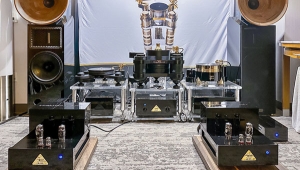| Columns Retired Columns & Blogs |
Sonic Frontiers SFD-2 D/A processor HDCD Overview
Sidebar 5: HDCD Overview
In case you missed my earlier reports, High Definition Compatible Digital is a sophisticated digital encoding and decoding process that preserves more musical information while remaining compatible with the CD's 44.1kHz, 16-bit storage limitation.
HDCD works on two levels: by preventing distortion that occurs during conventional coding, and by squeezing more information into the 44.1kHz, 16-bit data channel. The HDCD process starts by digitizing the analog input signal with a high sampling rate and a long word length (probably at least 88.2kHz and 20-bit resolution). Once this high-resolution representation of the music is in the digital domain, algorithms derived from Pacific Microsonics' psychoacoustic research decide what information in that signal is important musically, and what will be lost when the signal is decimated to 44.1kHz and 16-bit quantization. Eleven Motorola DSP56001 processors are required to perform the real-time analysis of the high-resolution signal—a huge amount of computing horsepower.
The information extracted from the high-resolution signal is encoded and transmitted in the least-significant bit of the 16-bit audio words. The 16 bits on an HDCD-encoded disc therefore include an encrypted control code. On playback through an HDCD-based digital processor, the control code tells the decoder how to restore the signal characteristics that were removed when the signal was reduced to the 44.1kHz sampling rate and 16-bit word length.
HDCD uses other techniques to increase the dynamic range and preserve the greater-than-20kHz bandwidth of transient signals.—Robert Harley
- Log in or register to post comments



































